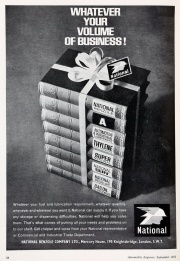National Benzole Co



of Wellington House, Buckingham Gate, London, SW1. Telephone: Whitehall 7812. Telegraphic Address: "Nabenzo, Souwest, London". (1937)
WWI Benzole extraction plants were installed alongside the coke ovens at collieries, gasworks, steelworks and tar distilleries for the manufacture of T.N.T. and other explosives. After the war a market developed for benzole blended with petrol as a motor spirit. The National Benzole Co was formed as a co-operative selling organisation by the benzole producers; the company obtained its petrol requirements from Anglo-Persian Oil Co.
1920 Newly formed National Benzole Company attempted to counter government arguments for restricting the price of benzole (which was cheaper to produce from coal than petrol at that time)[1].
1922 National Benzole announced it would continue to sell both National Benzole and National Benzole mix which was a 50:50 mix of benzole and petrol[2].
1927 AGM of Anglo-Persian Oil Co told that its UK refineries were supplying the petrol requirements of National Benzole Co, which was an association of the principal members of the coal industry operating coke ovens and gas works recovering benzole[3].
1937 Motor spirit distributors. [4]
1937 Listed Exhibitor - British Industries Fair. Display demonstrating the production of Benzole from British Coal and its advantages as a Motor Spirit. (Stand No. D.814) [5]
1938 the principal suppliers of petrol in the UK, namely Anglo-American Oil Co, National Benzole Co, Shell-Mex and B. P. and Trinidad Leaseholds, joined together with Government approval to form the Petroleum Board to consider the problems of petroleum distribution in the event of war.
1939 On 3rd September, the Board's became an executive body under Government direction. All products were sold under a Pool description, the selling price of each product being subject to Government control.
1939 See Aircraft Industry Suppliers
1948 The Petroleum Board was dissolved in June.
1956 Shell-Mex and BP made an offer to National Benzole Holdings to acquire their interests in National Benzole Co, essentially motor fuel and lubricant distribution[6].
See Also
Sources of Information
- ↑ The Times, 5 March 1920
- ↑ The Times, 28 September 1922
- ↑ The Times, 3 November 1927
- ↑ 1937 The Aeroplane Directory of the Aviation and Allied Industries
- ↑ 1937 British Industries Fair p394
- ↑ The Times, 30 November, 1956
- Competition Commission [1]























































